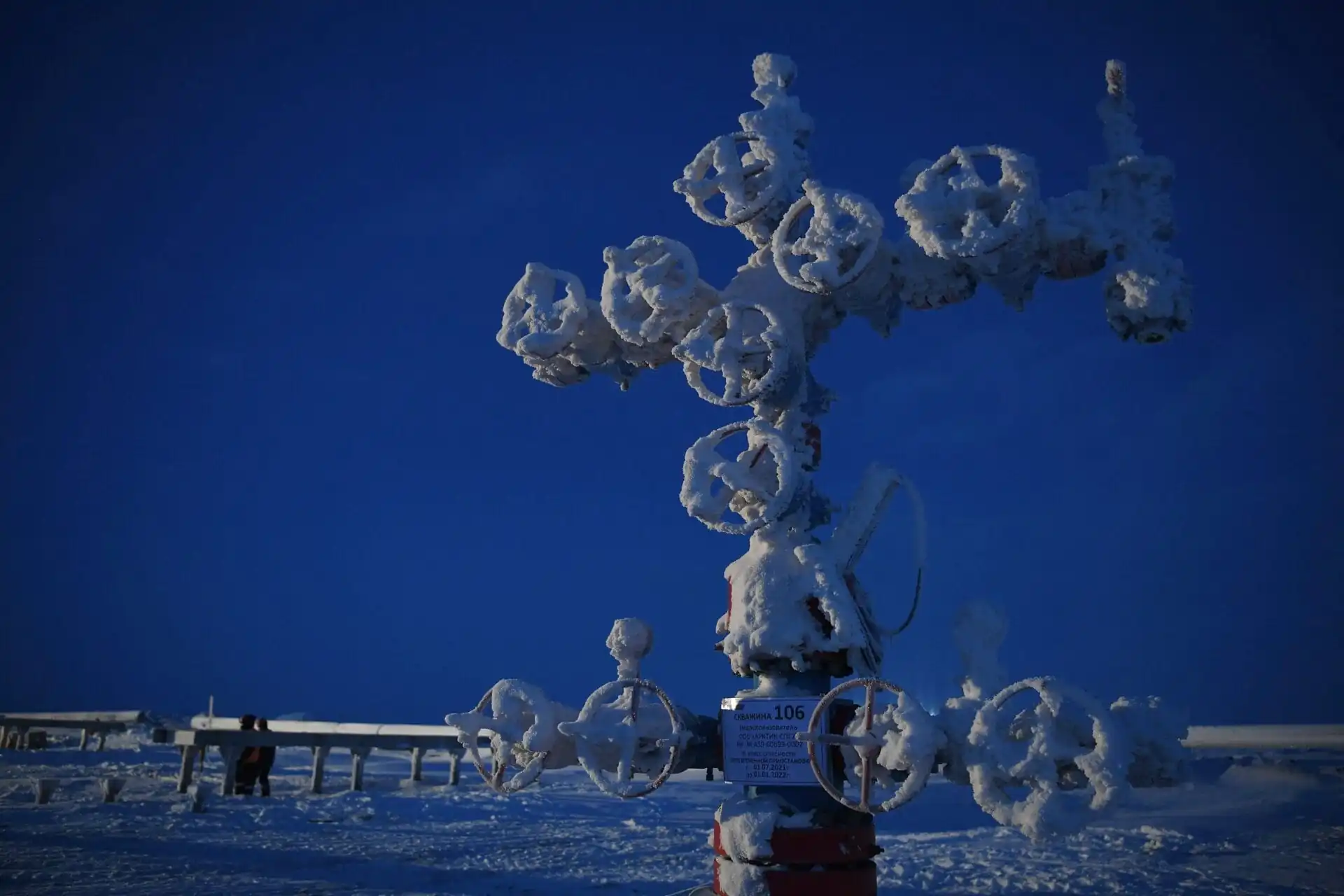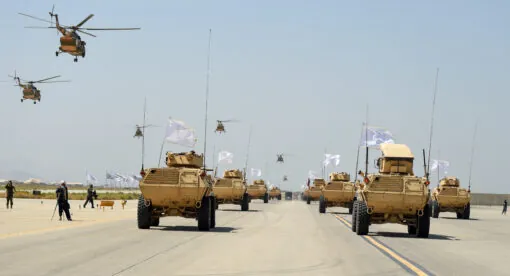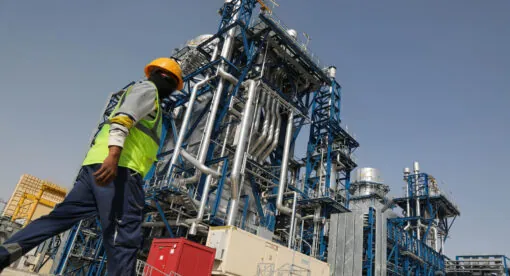Following sweeping Western sanctions and Europe’s decisive pivot away from Russian energy, analysts and observers across the West anticipated a severe and lasting blow to Russia’s energy sector. Yet this outcome has not fully materialized, raising concerns about geopolitical upheaval in global energy markets. Well before the invasion of Ukraine in 2022, Moscow had begun investing in liquefied natural gas (LNG) infrastructure, diversifying export routes, and improving operational efficiency. Now, as LNG reshapes global energy markets, it is also enabling Russia to reorient its exports toward Asia, deepen ties with partners like China and India, and assert a continued presence in global energy geopolitics. Russia is leveraging its LNG sector to turn geographic and political constraints into strategic assets, reshaping global energy flows, undermining sanctions, and challenging U.S. strategic influence across the Indo-Pacific. Russia’s ability to leverage LNG and strategic oil exports as a geopolitical tool, despite sanctions, poses a growing challenge for U.S. policymakers and underscores the shifting dynamics of global energy influence
This shift is also altering longstanding patterns of supply and demand, particularly in Asia, where the United States, despite being a rising LNG exporter in the region, faces structural challenges to expanding its presence, especially in terms of pricing and geographic distance. Understanding these evolving dynamics is essential for shaping future energy policy and responding effectively to the geopolitical consequences of a rapidly changing LNG landscape.
Russia’s Geography: A Liability and a Lifeline
Russia’s geographic disadvantage is no secret. It is bordered by the harsh expanse of Siberia to the east and north, the Arctic Ocean’s frozen shores to the far north, mountainous terrain in the south along the Caucasus and Central Asia, and the vast plains of Eastern Europe to the west, leaving much of its territory isolated, sparsely populated, and challenged by extreme climates. President Vladimir Putin faces the same geographic constraints that confronted Peter the Great: limited access to warm-water ports and harsh, unyielding terrain. As political scientist Nicholas Spykman famously put it: “Ministers come and go, but mountain ranges stand unperturbed.”
Yet alongside this geographic disadvantage lies a powerful advantage: Russia’s abundant natural resources, particularly energy, which is a core pillar of its strategic resilience in the face of shifting global energy dynamics. As of 2023, Russia holds the world’s largest proven natural gas reserves, estimated at approximately 46.8 trillion cubic meters. It is the second-largest LNG exporter to Europe, after the United States, with exports totaling around 23 billion cubic meters in 2024. In 2023, Russia was the world’s second-largest crude oil exporter, accounting for 11% of global exports despite Western sanctions. It exported approximately 240.8 million metric tons of crude, with China and India increasing purchases by 53% while Europe cut imports by 72%. Energy revenues play a critical role in funding Russia’s military and other key sectors, enabling the country not only to sustain economic growth but also to strengthen its regional influence and global presence. In 2024, oil and gas revenues accounted for approximately 30% of Russia’s federal budget, while military expenditure reached an estimated $149 billion, representing 7.1% of the country’s GDP and 19% of total government spending. This strategic linkage between energy revenues and defense spending has made Russia’s energy sector a focal point for international sanctions efforts, which seek to constrain the financial capacity underpinning its military operations.
With the longest Arctic coastline and the largest share of territory within the Arctic Circle, Russia holds a uniquely advantageous geographic position in the region, enabling early access to sea routes opened by melting ice and undersea resources. Moscow increasingly views the Arctic as a strategic asset with significant economic and geopolitical potential. As climate change accelerates ice melt, Russia is actively promoting the Northern Sea Route as a future shipping corridor for energy exports to Asia. While the route remains constrained and infrastructure-limited, the prospect of year-round access offers a potential alternative to major chokepoints and could significantly reduce LNG delivery times to markets such as China and Japan. According to a 2008 assessment by the U.S. Geological Survey, the Arctic is estimated to contain up to 30% of the world’s undiscovered natural gas and 13% of its undiscovered oil. Russia increasingly views these resources as a long-term hedge against declining revenues from traditional export routes.
Sanctions and the Eastern Pivot
When Russia invaded Ukraine in 2022, European countries that had been heavily dependent on Russian oil and gas, most notably Germany, Italy, and several Central and Eastern European states, began reducing imports and diversifying energy sources, aiming to weaken Russia’s position, even at significant cost to their own economies. This decision was also influenced by U.S. pressure, with Washington promising to help offset the gas shortfall, though at market prices that were significantly higher than the pre-war long-term contract prices for Russian pipeline gas. For the United States, this shift represented a strategic calculation: an opportunity to both profit from rising LNG exports and support European efforts to diversify supply and reduce reliance on Russia.
At the same time, however, Asian buyers like India and China significantly increased their Russian oil imports. According to a 2025 U.S. Energy Information Administration report, by 2024, 63% of Russia’s crude oil exports were rerouted to Asia and Oceania, up from just 34% in 2021. By the same year, 85% of Russia’s coal exports were also redirected to Asia and Oceania, rising from approximately 52% in 2021. Russia was able to rapidly expand its oil export market by offering discounted crude to the world’s two largest energy importers: China and India. In less than a year, Russia overtook Saudi Arabia as China’s top oil supplier, exporting around 2.2 million barrels per day in 2024.
Similarly, India increased its oil imports from Russia from negligible levels in early 2022 to approximately 1.92 million barrels per day by April 2025. These exports were sold at significant discounts, with prices often below the $60 per barrel price cap imposed by Western nations, making Russian oil particularly attractive to these buyers. This arrangement allowed China and India to reduce their historical dependence on Middle Eastern oil at a time when prices were rising. According to the New Delhi think tank Global Trade Research Initiative (GTRI) as reported by Reuters, India alone has saved at least $17 billion by increasing its imports of discounted Russian oil since early 2022. In 2024, over 60% of Russia’s seaborne oil exports were directed to India, making it a new key market for Russian oil.
While this pivot helped Russia sustain export volumes and secure strategic energy relationships, it came at a cost. For Russia, discounted oil exports are less a source of profit than a strategic necessity, preserving market access and geopolitical influence at the expense of fiscal stability. Even with stable export volumes in 2024, oil and fuel export revenues fell to near five-year lows by August 2025.
On Aug. 4, the United States escalated pressure on India over its continued imports of Russian oil, with President Donald Trump imposing an additional 25% tariff on Indian goods, doubling the rate to 50%. The tariffs, which took effect later that month, now threaten to undercut many of the economic gains India has made through discounted Russian oil. The new U.S. tariffs could slash Indian exports by over 40%, amounting to nearly $37 billion in trade losses for the current fiscal year.
The move, one of the sharpest trade escalations between the two countries in recent years, underscores Washington’s willingness to tie trade policy to foreign policy objectives, particularly in curbing revenues to Russia. India denounced the tariff hike as both unfair and politically motivated, making clear that it would continue its oil imports from Russia despite U.S. pressure. India’s procurement decisions are driven by market dynamics and broader geopolitical considerations, and ultimately guided by its own economic interests, irrespective of political pressure. The renewed tariffs have already pushed New Delhi to deepen engagement with U.S. adversaries such as Russia and China, potentially reshaping energy trade flows. This was most recently reflected in Prime Minister Narendra Modi’s participation in the 2025 Shanghai Cooperation Organization Summit in Tianjin, signaling a cautious diplomatic rapprochement with China.
Pipelines and LNG: Rewiring Russia’s Energy Geography
While these diversification efforts intensified following the invasion of Ukraine, Russia had been laying the groundwork to expand and reorient its export markets well before the war. Asia, in particular, offered long-term growth potential compared to the increasingly regulated and politically constrained European market. A notable example is the 2019 launch of the Power of Siberia 1 pipeline by Russia’s Gazprom and China’s CNPC, which began delivering natural gas from eastern Siberia to northeastern China under a 30-year supply agreement, signaling a strategic pivot toward deepening energy ties with Asia. In 2024, exports via the pipeline reached approximately 31 billion cubic meters (bcm), with full capacity of 38 bcm per year expected to be reached by the end of 2025.
Russia has also moved to deepen its pipeline connectivity with Asia through the proposed Power of Siberia 2 pipeline, an ambitious extension of its gas export strategy. Signed in 2014, the project aims to deliver 50 billion cubic meters of gas annually from the Yamal region to China via Mongolia. A legally binding agreement was signed in September 2025 to formalize tripartite cooperation among Russia, China, and Mongolia, marking a significant step toward implementation. If realized, it would allow Russia to reroute western-flowing gas toward Asia, strengthening long-term energy ties with China. Although the announcement was met with skepticism from energy analysts, who noted that China has not publicly confirmed the deal, it nevertheless underscores Moscow’s push to secure long-term export markets in Asia, particularly as gas revenues from Europe continue to decline.
Similarly, the Yamal LNG project, launched in 2017, ships LNG to China, Japan, and South Korea. Despite the Ukraine war and resulting sanctions, Yamal LNG maintains robust exports to both Asia and Europe, with 287 shipments departing in 2024, each carrying around 74,000 metric tons of LNG. Russia’s Arctic infrastructure, particularly the Yamal LNG project, has helped unlock otherwise inaccessible reserves. The Northern Sea Route also shortens delivery to Asia, bolstering its strategic LNG positioning. Specifically, 72% of Yamal LNG’s exports in 2023 were destined for Europe, and around 41 voyages from Yamal LNG were made to Asian ports in 2024, primarily to China.
That said, Arctic LNG 2, which is a much larger project also led by Novatek, has come under intense Western sanctions that have restricted access to essential liquefaction technology, financing, and shipping capacity. As noted by S&P Global, these sanctions have significantly slowed construction, delayed full operations, increased project costs, and cast doubt on the long-term viability of Arctic LNG 2 as a reliable export platform.
LNG’s Rise Amid Declining Oil Dependence
While Europe continues to import significant volumes of LNG from Russia, its reliance on Russian oil has markedly decreased. The European Union’s share of petroleum oil imports from Russia fell from 29% in the first quarter of 2021 to 2% by the second quarter of 2025. However, the shift away from Russian gas has been more fragmented and uneven. Several member states continue to import Russian LNG, particularly under long-term contracts signed before the war, such as France, Belgium, and Spain. Some countries remain more exposed than others due to a combination of limited LNG import infrastructure, existing regasification capacity, and binding contracts. For example, France still receives Russian LNG under pre-war contracts through TotalEnergies and Yamal LNG. The gap between declining oil imports and ongoing gas reliance reflects the EU’s greater dependency on natural gas, particularly for electricity and heating, making substitution more difficult in the short term. The EU’s ongoing gas reliance includes both pipeline gas and LNG.
Qatar was considered a strong potential alternative supplier, though its traditional reliance on long-term contracts made it less compatible with Europe’s shifting preference for flexible supply. In the wake of the war in Ukraine, European buyers increasingly moved to the LNG spot market, driven by the need for flexibility amid geopolitical uncertainty. This shift has also weakened Russia’s long-term energy leverage over Europe, accelerating the broader strategic decoupling between the two. Yet, the global LNG market is increasingly becoming a new arena of competition, one where Russia is seeking to reassert leverage, particularly in Asia, in ways that could undercut U.S. LNG market share, and limit the effectiveness of Western sanctions.
This trend has also been consistent with the decline in global oil demand partially due to improvements in energy efficiency in China and a broader global economic slowdown. While this trend could reduce the volume of oil imports from Russia by China and India, rising demand for LNG is creating new opportunities for Moscow to sustain energy revenues. According to an analysis by Shell, global LNG demand is projected to rise 60% by 2040. This growth is primarily driven by economic expansion in Asia, particularly China, and increasing demand for cleaner energy sources. In 2024, China’s imports of Russian LNG rose by 3.3% to 8.3 million metric tons, compared to 2023, making Russia the third-largest LNG supplier to China, after Australia and Qatar.
Another emerging factor is the rapid growth of AI and cloud computing, which is increasing demand for energy-intensive data centers worldwide. In many regions, natural gas, delivered via pipelines, is used as a primary fuel for gas-fired power generation to power these facilities, offering a reliable solution where renewable integration remains limited. In this context, natural gas is increasingly positioned as a transitional fuel to sustain these power-intensive operations. In addition to natural gas, LNG is increasingly emerging as a strategic complement, particularly in markets lacking robust pipeline infrastructure. Arthur D. Little highlights that LNG is being considered not just as a fuel source but also for its extremely cold temperature, which can help cool data centers more efficiently. This dual role makes LNG a useful solution for supporting the next generation of data centers, and increased demand is likely to keep Russia on the global gas map in the years ahead.
That is not to say that this opportunity will come without challenges. Russia is set to deal with growing climate risks in the Arctic that could threaten critical infrastructure and shipping routes, potentially delaying export schedules. While Moscow has sought to overcome these hurdles through domestic innovation and external financing, the success of these efforts remains to be seen. China has emerged as the primary financial partner for Russia’s energy projects, creating an increasingly asymmetrical relationship in which Beijing holds the upper hand. At the same time, Russia’s domestic environment is unstable, with high inflation rates and steep drop in non-military activity. The country is increasingly operating as a “two-speed economy,” where military production is prioritized while the civilian sector struggles.
While it remains to be seen how the Russian government will address these challenges, Russia remains well-positioned to benefit from the global rise in LNG demand. Its vast resource base, existing export infrastructure, and deepening energy ties with China and India, as well as other countries in Eurasia, provide a foundation for long-term strategic adaptation. This evolving partnership highlights a broader shift, one where geography no longer dictates destiny but is instead reshaped by energy security. Whether Moscow can fully realize this potential will depend not only on external demand but also on its ability to navigate the operational and financial constraints of a sanctioned environment.
LNG as a Geopolitical Tool
Russia’s ability to leverage LNG as a geopolitical tool, despite extensive Western sanctions, poses a growing challenge for U.S. policymakers. Without more coordinated efforts and targeted investment in alternative supply chains, Moscow is likely to expand its energy influence across Asia. The key concern is that a shrinking U.S. market share could leave major energy importers with little choice but to deepen their reliance on Russian gas, undermining both sanctions effectiveness and broader strategic influence in the Indo-Pacific.
This challenge is compounded by structural disadvantages the U.S. faces in Asian markets, not only due to higher pricing and longer shipping distances compared to Russia but also due to differing pricing models. U.S. LNG is typically priced off the Henry Hub benchmark, with additional costs for liquefaction and long-distance shipping, making it less flexible and often more expensive for many Asian importers. In contrast, Russia relies on oil-indexed contracts or spot-linked pricing – short-term prices tied to immediate market conditions – which can offer more competitive terms.
So far, Moscow has prioritized value maximization over defending market share, but this could shift. If U.S. LNG begins to threaten Russian dominance, particularly in Europe, Russia may respond more aggressively by leveraging its low production costs, spare export capacity, and underutilized pipeline infrastructure. In a sustained low oil price environment, Russia could undercut U.S. LNG and squeeze it out of price-sensitive markets. Additionally, Moscow benefits from shorter delivery routes to China via pipelines and seaborne shipping, while oil exports to India, though maritime, are facilitated by flexible pricing and discounted volumes that maintain Russia’s competitiveness.
U.S. LNG competitiveness could improve over the long term as new terminals on the West Coast and in Alaska come online, offering shorter shipping distances to Asia than existing facilities on the Gulf of Mexico. The Alaska LNG project, in particular, could significantly reduce transit times to Northeast Asian markets such as Japan, South Korea, and China, from about a month via the Gulf Coast to approximately eight days from Alaska. In addition, the United States benefits from its robust strategic presence across Indo-Pacific sea lanes. As a global naval power, the U.S. enjoys security and supply chain access advantages in critical chokepoints and maritime corridors, capabilities that Russia largely lacks. However, Russia retains a geographic edge through its existing overland pipelines to China and increasingly navigable Arctic shipping routes, especially for reaching East Asia. These U.S. projects remain in early stages and face regulatory and financing hurdles, meaning their ability to offset Russia’s near-term advantages will depend on sustained, strategic investment.
Policy Recommendations
For the U.S. to compete in the Asian LNG market, it needs to adopt more innovative and strategic approaches tailored to emerging demand patterns and geopolitical realities. These efforts should focus on enhancing LNG competitiveness, deepening strategic partnerships, and building out the necessary infrastructure to enable flexible and secure energy flows across the Indo-Pacific. This includes expanding financing mechanisms, enabling joint LNG ventures, and embedding clean energy solutions throughout the gas supply chain.
- Strengthen Strategic LNG Partnerships with Key Allies: The U.S. and its European allies should deepen strategic LNG cooperation with like-minded countries such as Japan, Australia, and South Korea, and more critically, India, a key Indo-Pacific partner whose rapidly expanding economy and rising energy needs make it an increasingly influential player in global energy markets. This can be done by building on existing cooperation frameworks and scaling LNG-related projects.
- Expand Clean Energy Engagement with India and Japan: The U.S. should strengthen the U.S.-India Strategic Clean Energy Partnership to expand clean energy use and reduce dependence on fossil fuels in key sectors like data infrastructure. Clean energy investment may be more costly than fossil fuels in the short term, but it can pay off over time, especially with the right financing, technology transfer, or joint infrastructure development supported by the United States.
That said, this should not preclude U.S.-India cooperation in the fossil fuel sector, where India remains a potential long-term customer for U.S. oil and gas exports. This is an opportunity Washington could leverage to anchor long-term energy cooperation while curbing the geopolitical influence of Russian and Chinese energy flows across the Indo-Pacific. This would be a more constructive approach given India’s central role in the Quad, rather than relying solely on punitive measures, such as tariffs.
With Japan, expanding the U.S.-Japan Clean Energy Partnership to include LNG decarbonization technologies, such as methane mitigation and hydrogen-ready terminals, would help position U.S. LNG as a cleaner, more competitive option in the region.
- Support LNG Infrastructure and Transit Corridors: To complement these efforts, the United States should continue investing in strategic transit and infrastructure corridors that support diversified energy flows. One example is the India-Middle East-Europe Economic Corridor (IMEC), a U.S.-backed initiative that could help build trade routes for LNG, clean energy technologies, and critical minerals that bypass both China and Russia. Strengthening such corridors would improve energy connectivity between India, the Gulf, and Europe, supporting U.S. allies, reducing regional dependence on Russian infrastructure, and enabling more flexible, secure supply chains. As Kent Calder notes in his book “Eurasian Maritime Geopolitics,” control over chokepoints and connectivity infrastructure is increasingly central to geopolitical leverage, particularly as energy security and supply chain resilience are increasingly intertwined.
These targeted efforts would strengthen U.S. market positioning, improve regional energy resilience and connectivity, and provide a path toward a credible alternative to Russian gas. More broadly, the United States must adopt a proactive, rather than reactive, approach to its energy relationships in Asia, where much of future global demand will be concentrated, by scaling up investments in advanced energy technologies. In today’s geopolitical landscape, energy, not just military power, has become a central arena of global competition.
The views expressed in this article are those of the author and not an official policy or position of New Lines Institute.






